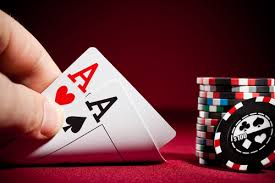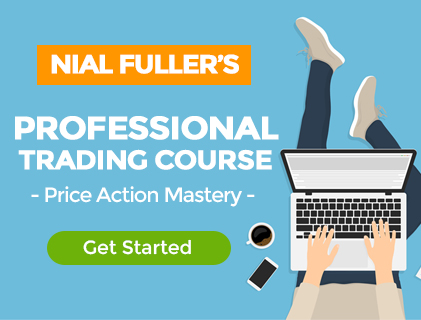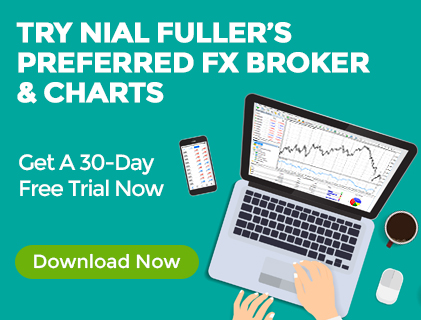What Professional Poker Players Can Teach You about Trading
 There are many similarities between the poker and trading worlds, and as traders, we can learn a lot from some of the top poker players.
There are many similarities between the poker and trading worlds, and as traders, we can learn a lot from some of the top poker players.
As Brandon Adams, a professor of behavioural finance at Harvard University’s Department of Economics said, “Some of the best candidates for Wall Street trading jobs are the professional card players at FullTiltPoker and similar web sites.”
As any good poker player knows, if you manage your risk properly and execute your edge with consistency, you won’t be gambling, you’ll simply be playing the odds. Poker (and trading) becomes gambling when the player becomes emotional, throws away their discipline and stops managing their chips (money) properly.
So what are some of the most important things we can learn from professional poker players? Let’s discuss…
Strategic thinking
Assuming you have a poker strategy that gives you an above average expectancy over a series of hands, you know that you need to execute your strategy or edge over a large enough series of hands to see it play out in your favour.
It would be short-sighted to get emotional and worked up after losing just two or three hands at the beginning of a poker game. A professional poker player knows that they need to play several decks to have the odds work in their favour. It becomes a simple numbers games; the more hands you play whilst sticking to your poker edge, the better chance you have of coming out ahead.
So, the first thing we can learn from poker players is that we need some type of strategy or edge that gives us a positive expectancy over a series of hands / trades. For a trader, and more specifically for me and my students, this means we use price action trading strategies to find entries into the market that give us a better than random expectancy in the market. Now, that doesn’t mean we will win every trade, on the contrary, it means we will lose and win some, but if we stick to the method over a large enough sample size, we should come out ahead.
Obviously, patience to wait for our trading edge to present itself (whilst not over-trading) and the discipline to stick to it are paramount here. Just as a poker player needs to have patience and discipline to stick with this poker edge.
Knowing when to hold ‘em and when to fold ‘em
Perhaps the most obvious lesson we can learn from professional poker players is knowing when to hold ’em and when to fold ’em. (Note: I wrote an article many years ago about this concept here)
As the old Kenny Rogers song goes “You’ve got to know when to hold ‘em, when to fold ‘em, know when to walk away, know when to run. You never count your money when you’re sittin’ at the table, there will be time enough for countin’, when the dealin’s done.”
If you want to hear this all time classic song “The Gambler'” by Kenny Rogers , you can play it below.
Now, as you may well already know, exiting trades can be one of the most difficult aspects of the whole process. But, just as a poker player knows when to fold his hand and when to hold it, you will need to know when to take a loss and when to hold a trade and keep ‘playing’.
Luckily, for us traders, whether to fold or hold is a little easier because we can simply set and forget our trades as I typically do. The reason we can do this is because we already know what our trading edge is and we already have our risk predefined, so when our trading edge forms in the market, we simply set the trade up and then ‘forget’ about it.
Now, when I say ‘forget about it’, I am exaggerating a little bit; I don’t mean you never check on your trade or re-evaluate the market conditions as the trade progresses. What ‘set and forget’ trading is really all about, is a mindset or an attitude about how you will manage your trades. The idea is that your default approach to managing your trades should be to let the market do its ‘thing’ without your interference. Markets ebb and flow, this is normal, and you can’t try to intervene in your trades at every turn against your position, nor should you get excited and add to them every time they surge in your favour.
The true skill in trade management, lies in being able to read the price action and identify any signs of a significant change in market dynamics or conditions, which might adversely affect your trade. IF you identify such a scenario, then you could consider closing your trade before it hits your stop loss or your profit target; a manual exit. However, in my experience, these instances are the exception, not the rule, and most of the time it’s best to predetermine what you will do after a trade is live and then stick to that plan until your trade either hits your stop loss or your profit target.
Risk management
In poker, managing your chip stack is a huge part of the strategy of the game. You don’t want to go betting all your chips on a weak hand, as any poker pro knows. You also don’t want to go too light on a strong hand; you’ve got to know when to push when you have the edge, but also how not to go bust.
A professional trader knows that when a low-risk opportunity is revealed, the trade must be placed, just as when a poker pro gets pocket aces with an ace on the flop, he must keep playing and betting. Conversely, when a poker player is outmatched, or was dealt a weak hand, he will fold quickly in order to preserve his chips for a better hand later on.
One big difference between poker and trading, is that in any poker tournament there is a start and a finish. However, in trading, we decide when the ‘game’ is over; we decide to continue trading or stop. This can become a big problem for traders because it causes them to trade too much which obviously results in losing money, essentially it is one way that trading can turn into gambling if we let it.
You’ve got to know when your edge is present and when it’s not, and if it’s not present, you need to walk away from the charts. If you sit there trying desperately to ‘find a trade’, you are probably going to take a low-probability trade which means you’re risking your money on a very low chance of winning.
The goal in trading as in poker, is to manage your capital / trading chips so that you don’t lose too much from emotion or weak hands, so that when the strong hands and high-probability trades come along, you can get as much money as you can out of them. Obviously, poker has ‘bluffing’ which is another aspect to the strategy of it, whereas trading does not, and in my opinion, this actually makes trading easier since you’re really just playing against yourself.
Emotional stability – remaining calm
Any professional poker player will tell you that in order to win a tournament you need the ability to process information quickly and make an immediate decision with little self-doubt. Trading is the same way; you cannot doubt yourself or your trading method, when a trade is present that meets your trading plan criteria, you need to act decisively and without hesitation or doubt.
A person who shows too much emotion in poker, or how doesn’t really understand the game, will lose their poker chips quickly. In trading, the trader who makes decisions based on emotion will quickly lose a lot or even all the cash in his or her trading account.
In conclusion, there is a multitude of lessons you can learn from professional poker players. Trading and poker both involve similar characteristics of risk taking, probabilities and mental discipline. Some of the world’s most successful money managers were once professional card players. Of the more famous, Bill Gross of PIMCO (the world’s largest bond fund) says that in order to be a successful investor, “one has to be part card player, and apart analyst.”
To learn how I trade the market with a professional card players mentality, check out my trading course.






geat work
Great Article!
I think we also need to consider the probability that our target 2R or 3R will be hit in a trade or series of trades. Like when you set-up a stop loss, say 100pips distance, 2R would be 200 pips.. but if there is a strong resistance/support level at 150 pips distance, that will lessen the probability that 2R will be hit. Will it be good to also consider any blocking level when we enter a trade? Blocking level like a strong resistance level above our price entry level that may block our desired TP. Just a thought..
Thanks! ;-)
In this scenario, the best thing I will do is to place my stop at break even. My trading experience has taught me never to close my trades manually. So, I make sure my edge is present, and place my stop loss.
Hi Nial, i have a question. 1:2 or 1:3 risk reward is good, but if we think in terms of probabilities, the possibility of any one trade’s reaching 1R is more than reaching 3R.
doesnt it affect the win rate, because if a trade reached 3R, we say it is a win, does it?
thanks..
ozkan
Your maths is correct, 1r trades are reached more than 3r trades. As traders we will over time average a win rate of 30 to 50%, so it’s important we have a high risk reward ration on average, if we just aim for 1r trades it wont be profitable in the long run.
Good advice to all traders.Thanks and God bless.
Nial
Excellent article. Its a real eye opener.
Thanks and keep posting.
all the Best in 2016.
John
Thanks Sir
@ Olatunde, I made the same mistake some year back. though ’twas hard on me, but coach Nail really help & take mw back to biz.
Excellent article…
Hey Nial, great article. I been following you for a while now and have really learn so much from you. Even though I haven’t purchased your course you still taught me a lot. I day trade another system that I bought and is doing quite well, mainly do to your post and articles. My favorite is ” Trade Forex Like a Sniper….” . Just really wanted to say thanks and let you know that you are a true inspiration/mentor to me..Thanks!
Well said.
I just made an emotional mistake of exiting out of fear; yet the market eventually reached my TP! Anyway am really learning now.
Thanks.
Great article!
A good article. I’m not a poker player but I understand that it takes very little time to learn the basics of the game but years to master it… Just like trading
Great article as usual. The underlined factors are very essential to the success of any forex trader. Nice one Nial.